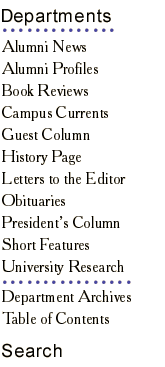

|
 Cover photo by Doug Prince 
|
Boogeying on Bonfire Hill By Mylinda Woodward '97 "The veteran is a hard person to sell anything to," observed an editorial in The New Hampshire in 1946, when almost two-thirds of the students on the UNH campus were enrolled under the GI Bill. "Campus activities must be made attractive to him or he will ignore them."
Indeed, with the return of the veterans of World War II, the entire university community seemed to become aware that UNH didn't have a great deal to offer in the way of entertainment--not for men and women who had seen London and Paris, anyway. The campus didn't even have a recreation center to provide a focal point for extracurricular activities. Earlier in the decade, UNH alumni had proposed raising funds for a student union building that would stand as a memorial to the 2,300 New Hampshire veterans who lost their lives in the first and second world wars and the Korean War. The fund-raising effort was not aggressive, however, and money came in slowly. In the meantime, the university acquired a former United Service Organization recreation building in Ayers, Mass., and had it trucked to the campus in sections. The building was put back together on a site known as Bonfire Hill, the traditional location for pep rallies and victory celebrations. President Harold Stoke offered a $25 prize for a name for the temporary recreation center, and the winning entry was "the Notch," a reference to the cut made through the rocks at the bottom of the hill when the sidewalk was laid between Thompson Hall and the Commons (now Huddleston Hall).
The Notch was a single-story, white wooden building. It housed a snack bar, two offices for student organizations, a lobby and a large function room. It was understood that this building would soon be replaced when the alumni raised enough money to build a permanent student union. But like many other "temporary" structures on campus, it lasted far longer than anticipated, serving as the hub of student activities for more than 10 years. Activities at the Notch, organized by Student Union committees, included Ping-Pong and bridge tournaments, song fests, debates and dances featuring student bands such as Andy Hastings '46 and his Notchmen. In a 1967 interview, Richard Stevens '51 recalled, "There were about 3,800 students here at that time, and everything that happened, happened at the Notch. It was crowded, but we had a tremendous amount of fun." Fund raising for a permanent building progressed in fits and starts, and it wasn't until 1955 that a groundbreaking ceremony was finally held after a home football game. The Notch was torn down in May 1957, and the million-dollar Memorial Union Building was dedicated on Oct. 12 that year.
The modern multi-level building, a somewhat controversial departure from the neo-Georgian architecture of other campus buildings, contained rooms for all kinds of activities and functions. Students could get a bite to eat in the large cafeteria, enjoy a game of table tennis, billiards or bowling, or watch television in a comfortable lounge. The lowest level of the building provided office space for a growing number of student organizations. The Student Union Organization tried to reach all types of students with a diverse schedule of activities. Many events that had become traditions at the Notch--the annual talent show, the Night of Sin (with faculty members presiding at gaming tables) and the semi-formal spring dance--were continued in the new building. The 1960s introduced a Miss UNH pageant, the College Bowl and political debates. In 1966, the Student Committee on Popular Entertainment was formed and began booking some of the biggest names in rock music for campus performances. From 1976 until 1987, there was even a MUB Pub that served beer and featured nightly entertainment provided by WUNH disc jockeys, vintage movies or local rock bands.
In 1994, the 37-year-old MUB was expanded and thoroughly renovated. At the reopening celebration, Rae Ann Hoyt Chrane '84 spoke for many former students when she said, "When adults hit their 40th year, they are often teased about being over the hill. What strikes me about the MUB is that it never seems over the hill." ~ Mylinda Woodward '97 is the assistant university archivist. Archives of history columns. blog comments powered by DisqusCurrent issue | Past issues | Class notes Department archives | Send a letter/news | Address updates Advertise | About UNH Magazine | Alumni home | UNH home University of New Hampshire Alumni Association 9 Edgewood Road Durham NH 03824 (603) 862-2040 alumni@unh.edu |